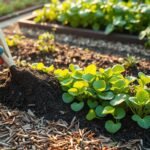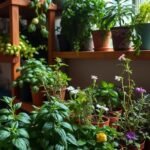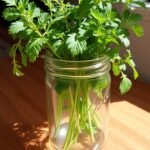Imagine stepping outside to pick crisp lettuce for tonight’s salad or plucking sun-warmed tomatoes from your own yard. Growing edibles brings fresh flavors, nutritional benefits, and cost savings straight to your kitchen. Best of all? You don’t need expert skills or endless free time to succeed.
Many new growers find working with soil surprisingly calming. Tending plants becomes therapy with tangible rewards – a chance to unplug while cultivating food security. Studies show even small green spaces improve mental well-being, making your plot a personal wellness retreat.
This guide focuses on smart strategies for first-time growers. We’ll show you how to select resilient varieties that practically care for themselves. Forget complex schedules – you’ll learn to work with nature’s rhythms rather than against them. From container setups to pest-resistant picks, we’ve got solutions for every challenge.
Concerned about space? Many thriving edible gardens fit neatly on patios or balconies. Worried about failures? We’ll share proven methods to minimize risks. By starting with forgiving plants, you’ll build skills naturally while enjoying harvests all season.
Getting Started with Your Vegetable Garden
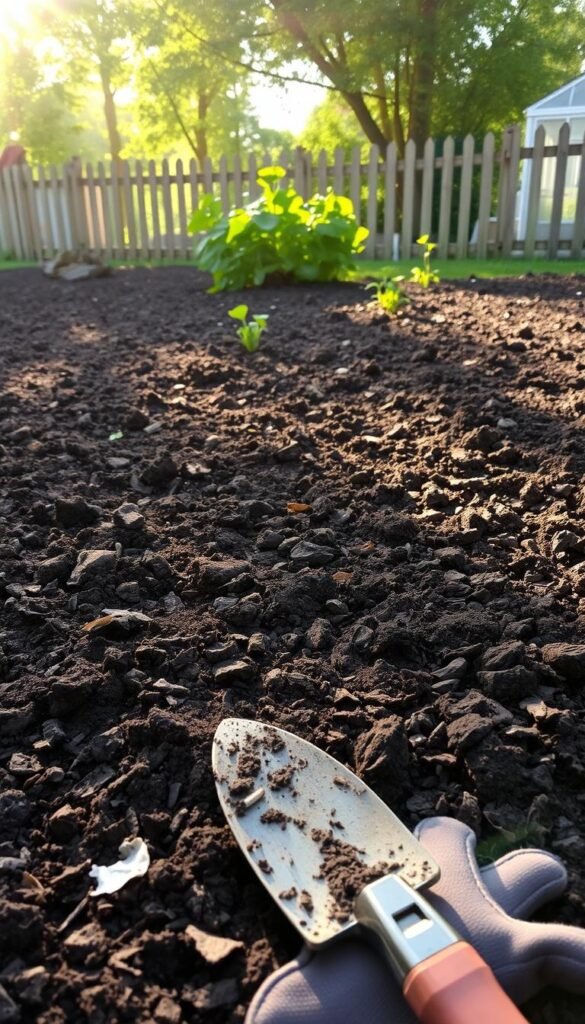
The key to a thriving plot lies in three simple factors: sunlight, soil quality, and smart positioning. Let’s break down these essentials so you can create ideal conditions for your plants without wasting time or resources.
Understanding Your Soil, Sun, and Space
Start by scouting areas receiving 8+ hours of direct sunlight daily. Leafy greens tolerate some shade, but tomatoes and peppers demand full sun. Use a compass app to track light patterns throughout the day.
Test your soil using a $10 kit from garden centers. Most edibles prefer slightly acidic conditions (pH 6.0-7.0). For quick fixes, consider raised beds filled with quality garden – they bypass poor native earth and improve drainage.
| Location Factor | Ideal Condition | Quick Fix |
|---|---|---|
| Sun Exposure | 8+ hours daily | Container relocation |
| Water Access | Within 10 feet | Rain barrel installation |
| Soil Quality | Loamy texture | Raised bed setup |
Essential Tools and Materials for Beginners
Keep your toolkit simple: a trowel, pruning shears, and watering can cover most needs. Add these space-saving items:
- Self-watering containers for small patios
- Biodegradable pots for easy transplanting
- Expandable hose for efficient watering
Measure your available area before shopping. A 4x4ft raised bed yields 16 square feet of growing space – enough for 10-12 plants. Remember: Starting small prevents overwhelm and lets you learn through gradual expansion.
Planning Your Low-Maintenance Garden Layout
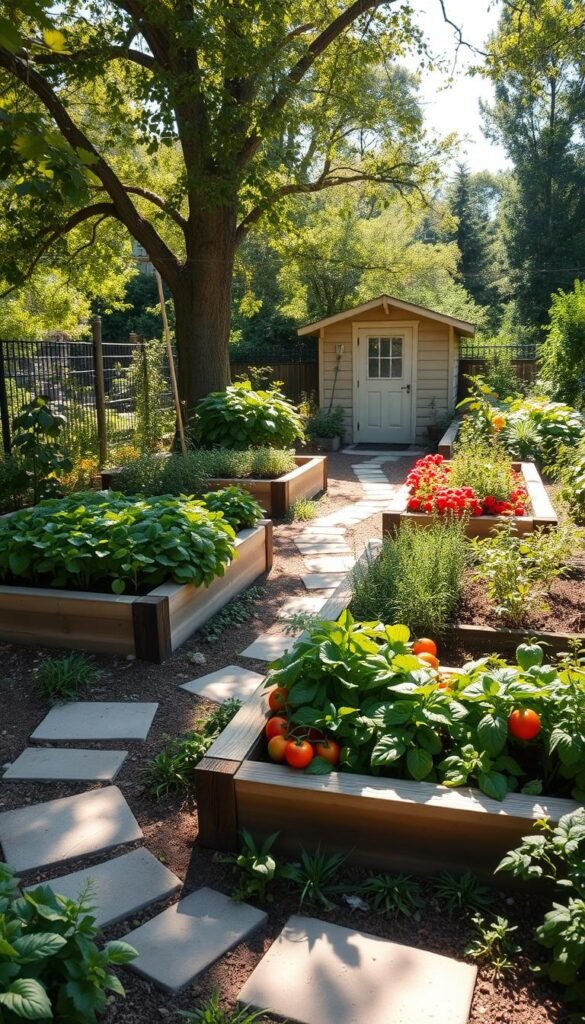
A well-organized plot begins with smart preparation. Starting your layout design during winter months gives you time to research varieties and avoid common pitfalls. Many seasoned growers swear by this approach – it’s like having a roadmap for your green thumb adventures.
Creating a Simple Garden Plan
Begin by sketching your available space on grid paper – 1 square equals 1 foot. This visual tool prevents overcrowding and helps match ambitions with reality. Check your USDA hardiness zone and local frost dates to schedule planting windows accurately.
| Planning Step | Benefit | Time Saver |
|---|---|---|
| Scale Drawing | Prevents overcrowding | Reduces mid-season fixes |
| Equipment List | Identifies needs early | Avoids last-minute shopping |
| Succession Schedule | Extends harvests | Maximizes bed usage |
Mapping Out Raised Beds and Garden Beds
Raised beds offer better drainage and easier access – perfect for root crops and heat-loving plants. Leave 18-24″ between beds for comfortable movement. Mark trellis locations and irrigation routes directly on your plan to avoid disrupting plants later.
Create three separate sketches for spring, summer, and fall layouts. This rotation strategy keeps soil nutrients balanced while ensuring continuous harvests. Pair quick-growing radishes with slower peppers to make the most of your space all year.
Easy Vegetable Garden Ideas for Beginners: Low-Maintenance Crops to Grow
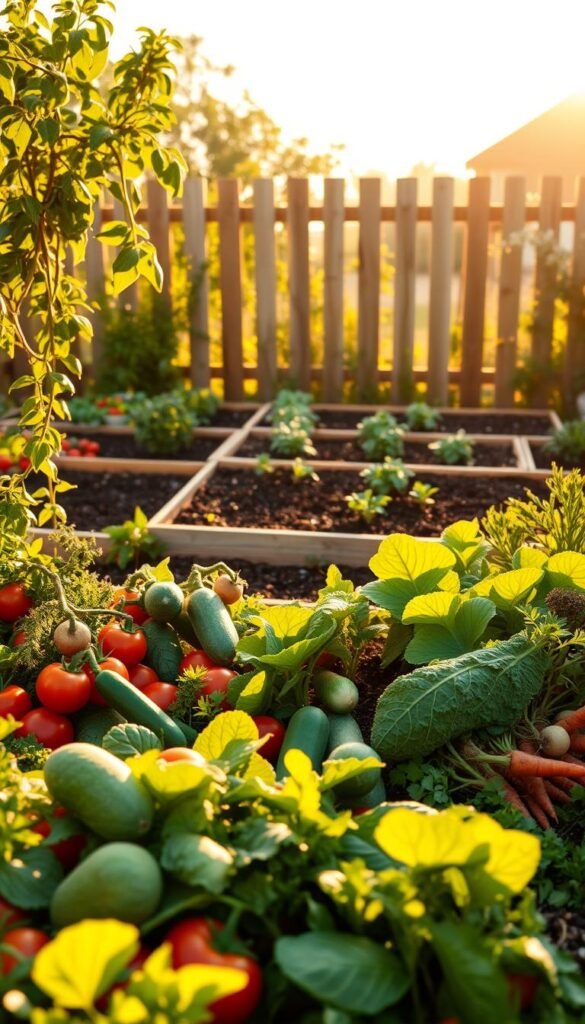
Fresh salads and roasted veggies taste better when you grow them yourself. The secret? Start with plants that thrive with basic care. Our handpicked list skips temperamental options, focusing instead on varieties that bounce back from minor mistakes.
Seasonal planning is your ally. Cool-weather crops like spinach and kale flourish in spring’s mild temperatures. When summer heats up, switch to cherry tomatoes and zucchini – these sun-lovers produce heavily with weekly watering. Check this seasonal guide:
| Season | Top Picks | Key Trait |
|---|---|---|
| Spring | Radishes, Peas | Fast growth |
| Summer | Green Beans, Basil | Heat tolerance |
| Fall | Garlic, Swiss Chard | Cold resistance |
Mix quick growers like lettuce with slower vegetables like carrots. This “tag team” approach keeps your garden productive. Many easy-grow options offer built-in pest resistance, reducing your workload.
Why does variety matter? Diverse plants create natural pest barriers and improve soil health. Start with 3-5 types from our list to build skills without stress. Remember – successful gardens grow from smart choices, not constant effort.
Selecting the Best Vegetables and Herbs
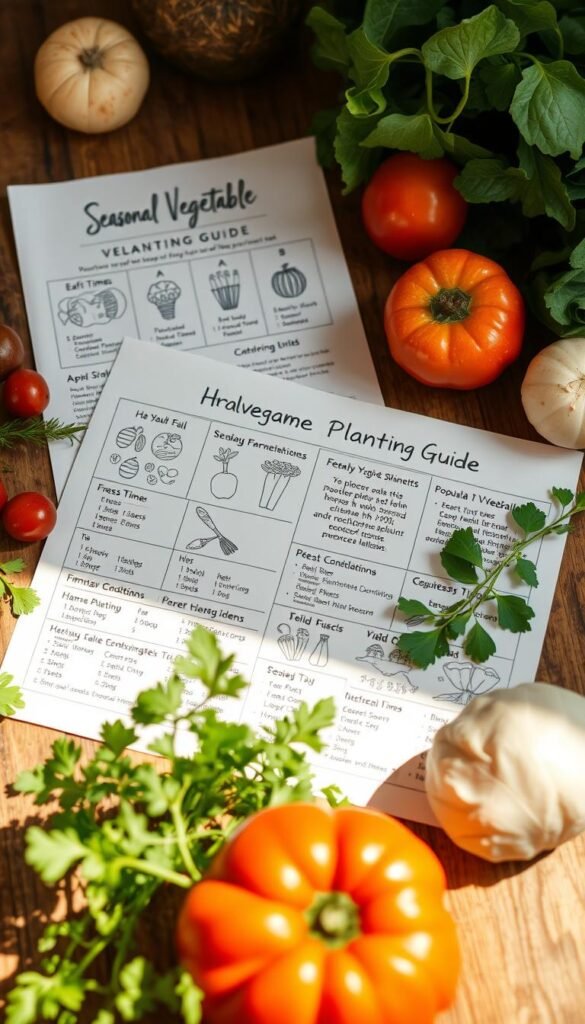
Timing your plantings unlocks nature’s full potential. Matching edibles to their preferred season creates healthier plants and bigger harvests. Let’s explore which varieties thrive when temperatures dip or soar.
Cool-Season Crops for Spring and Fall
These hardy performers sweeten with frost exposure. Sow beets and carrots as soon as soil becomes workable. Kale and spinach flourish in 50-70°F weather – perfect for early spring and crisp fall days.
Garlic and onions demand autumn planting. Their bulbs develop strong roots through winter, yielding robust crops by summer. Consult your hardiness zone guidelines for precise timing.
Warm-Season Essentials for a Bountiful Harvest
Tomatoes and peppers need consistent warmth. Wait until soil reaches 60°F – use a thermometer, not just calendar dates. Bush beans and basil thrive in heat, producing nonstop until frost.
| Cool-Season Stars | Warm-Season Favorites | Key Difference |
|---|---|---|
| Peas (55-65°F) | Eggplant (70-85°F) | Soil temp requirements |
| Lettuces (60°F) | Peppers (65°F+) | Frost tolerance |
Herbs offer year-round flexibility. Annuals like cilantro bolt in summer heat but reseed readily. Perennial rosemary and thyme survive winters in zones 5-9, returning stronger each season.
Maximizing Your Growing Space with Raised Beds and Containers
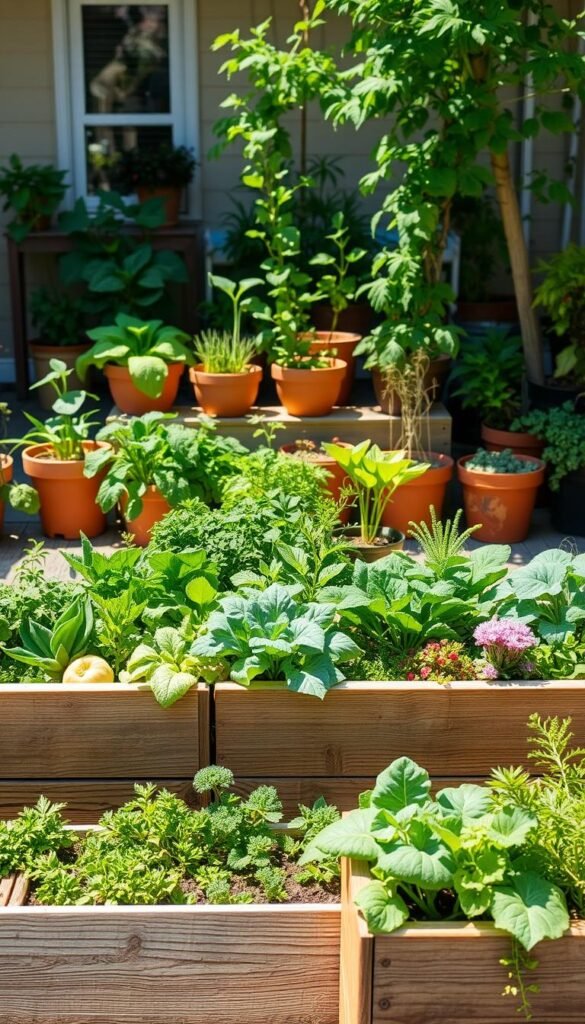
Transforming tight areas into lush food producers starts with smart space solutions. Whether you’re working with compact yards or concrete surfaces, these methods let you cultivate fresh flavors without sacrificing style or comfort.
Benefits of Raised Garden Beds
Raised beds act like custom buffets for your plants. You fill them with perfect soil blends – no battling clay or rocks. These elevated beds warm faster in spring, letting you start vegetables weeks earlier than ground plots.
Roots stretch deeper in loose earth, creating sturdier plants that handle drought better. The height reduces back strain during harvests – no more kneeling in mud. Plus, defined space helps prevent overcrowding and disease spread.
Container Gardening Tips for Limited Spaces
Urban growers rejoice – containers turn fire escapes into tomato jungles. Match pot sizes to crop needs: 5-gallon buckets for peppers, window boxes for herbs. Lightweight fabric containers let you chase sunlight across patios.
Group vegetables with similar water needs to simplify care. Add casters under heavy pots for effortless repositioning. Remember: quality potting mix beats garden soil in containers – it prevents compaction and nutrient loss.
Low Maintenance Strategies for Watering and Weeding
Smart gardeners know efficiency starts below the surface. Two simple upgrades transform tedious chores into set-and-forget systems: protective ground covers and targeted irrigation. Let’s explore how these solutions work together to save effort while boosting plant health.
Soil Armor That Works Double Duty
Spread 2-3 inches of mulch after seedlings establish strong roots. This living blanket keeps soil moist between rains and blocks weed seeds from sprouting. Straw or shredded bark breaks down slowly, feeding earthworms as it decomposes.
Proper timing matters. Apply mulch too early, and you’ll trap cool spring soils. Wait until plants reach 6 inches tall – their leaves will shade the mulch layer naturally. Renew coverage mid-season to maintain protection.
Precision Watering Made Simple
Snake soaker hoses through beds before mulching. These porous tubes deliver moisture straight to roots while keeping leaves dry. Connect to a timer for hands-free operation – perfect for vacation weeks or busy schedules.
| Material | Water Savings | Weed Reduction |
|---|---|---|
| Wood Chips | 30% less | 85% fewer |
| Straw | 25% less | 75% fewer |
| Compost | 20% less | 60% fewer |
Pair these techniques with strategic bed layouts for maximum impact. You’ll spend less time dragging hoses and more moments enjoying your thriving garden.
Nurturing a Family-Friendly Garden
What if your outdoor space could become a living classroom? Involving loved ones in growing food strengthens bonds while teaching valuable skills. Shared responsibility means lighter workloads and bigger rewards when harvests arrive.
Fun Ways to Involve Kids in Planting
Let young helpers choose colorful varieties like rainbow chard or purple beans. Assign them “ownership” of specific plants using painted markers. Kids adore tracking progress – create growth charts with weekly measurements.
Turn weeding into treasure hunts for earthworms. Use repurposed kitchen containers as starter pots for fast-growing vegetables like snap peas. When harvest time comes, let little hands rinse produce or arrange fruit displays.
Seasonal traditions keep the garden exciting year-round. Press fall leaves into bookmarks. Make spring seed bombs from recycled paper. These shared moments create lasting memories while nurturing your family’s connection to nature’s cycles.

